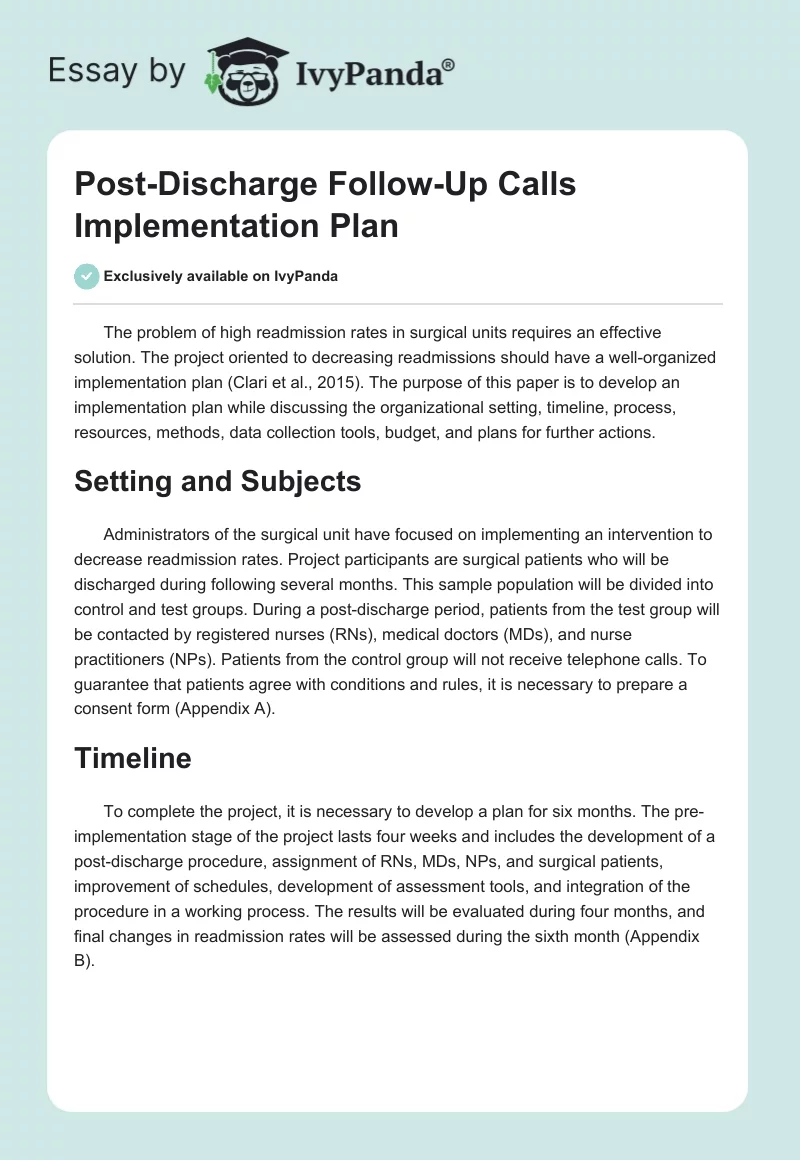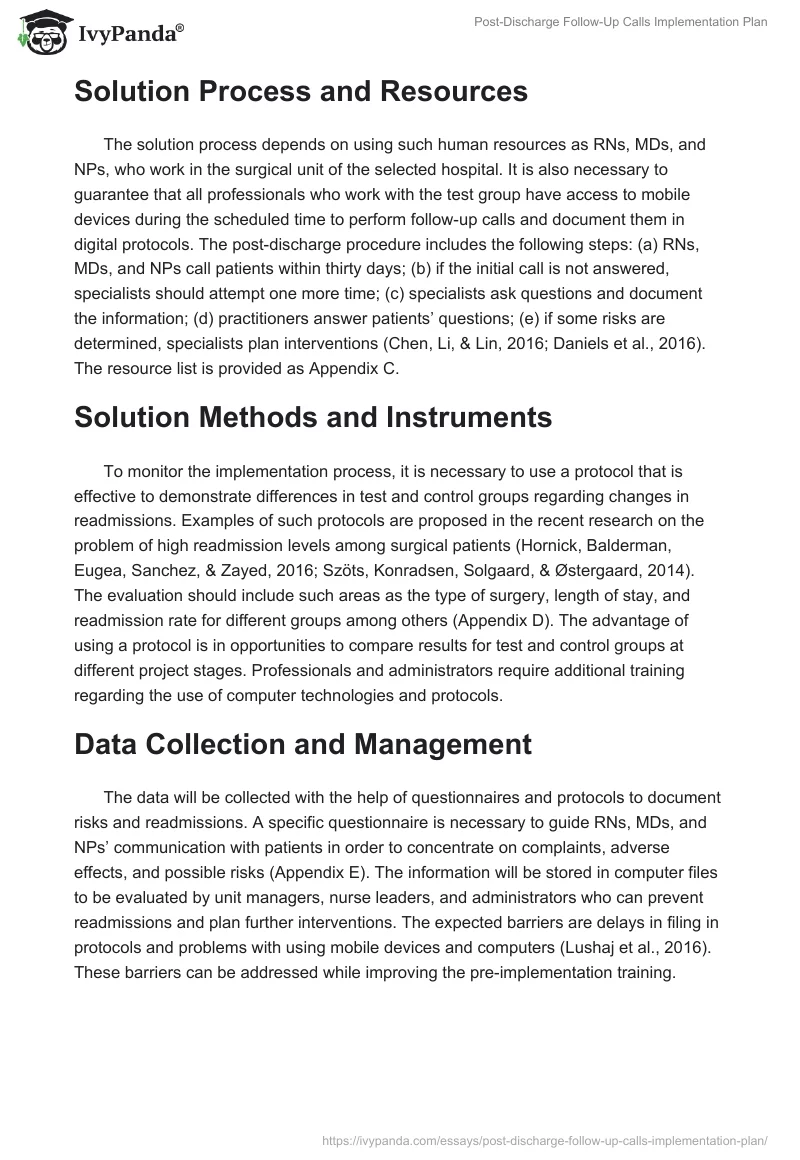The problem of high readmission rates in surgical units requires an effective solution. The project oriented to decreasing readmissions should have a well-organized implementation plan (Clari et al., 2015). The purpose of this paper is to develop an implementation plan while discussing the organizational setting, timeline, process, resources, methods, data collection tools, budget, and plans for further actions.
Setting and Subjects
Administrators of the surgical unit have focused on implementing an intervention to decrease readmission rates. Project participants are surgical patients who will be discharged during following several months. This sample population will be divided into control and test groups. During a post-discharge period, patients from the test group will be contacted by registered nurses (RNs), medical doctors (MDs), and nurse practitioners (NPs). Patients from the control group will not receive telephone calls. To guarantee that patients agree with conditions and rules, it is necessary to prepare a consent form (Appendix A).
Timeline
To complete the project, it is necessary to develop a plan for six months. The pre-implementation stage of the project lasts four weeks and includes the development of a post-discharge procedure, assignment of RNs, MDs, NPs, and surgical patients, improvement of schedules, development of assessment tools, and integration of the procedure in a working process. The results will be evaluated during four months, and final changes in readmission rates will be assessed during the sixth month (Appendix B).
Solution Process and Resources
The solution process depends on using such human resources as RNs, MDs, and NPs, who work in the surgical unit of the selected hospital. It is also necessary to guarantee that all professionals who work with the test group have access to mobile devices during the scheduled time to perform follow-up calls and document them in digital protocols. The post-discharge procedure includes the following steps: (a) RNs, MDs, and NPs call patients within thirty days; (b) if the initial call is not answered, specialists should attempt one more time; (c) specialists ask questions and document the information; (d) practitioners answer patients’ questions; (e) if some risks are determined, specialists plan interventions (Chen, Li, & Lin, 2016; Daniels et al., 2016). The resource list is provided as Appendix C.
Solution Methods and Instruments
To monitor the implementation process, it is necessary to use a protocol that is effective to demonstrate differences in test and control groups regarding changes in readmissions. Examples of such protocols are proposed in the recent research on the problem of high readmission levels among surgical patients (Hornick, Balderman, Eugea, Sanchez, & Zayed, 2016; Szöts, Konradsen, Solgaard, & Østergaard, 2014). The evaluation should include such areas as the type of surgery, length of stay, and readmission rate for different groups among others (Appendix D). The advantage of using a protocol is in opportunities to compare results for test and control groups at different project stages. Professionals and administrators require additional training regarding the use of computer technologies and protocols.
Data Collection and Management
The data will be collected with the help of questionnaires and protocols to document risks and readmissions. A specific questionnaire is necessary to guide RNs, MDs, and NPs’ communication with patients in order to concentrate on complaints, adverse effects, and possible risks (Appendix E). The information will be stored in computer files to be evaluated by unit managers, nurse leaders, and administrators who can prevent readmissions and plan further interventions. The expected barriers are delays in filing in protocols and problems with using mobile devices and computers (Lushaj et al., 2016). These barriers can be addressed while improving the pre-implementation training.
Budget
The implementation plan is feasible as the majority of expenses are covered by the hospital because this intervention was planned previously. For the researcher, costs are also limited as there is no need for specific equipment to implement the intervention. Computer-related costs, including the use of hard copies, are presented in Appendix F.
Plans to Continue and Discontinue the Project
After the project completion, it is important to analyze outcomes and propose using a post-discharge follow-up call as a procedure included in the protocol. It is expected that the intervention will show the significant decrease in readmission rates. Therefore, it is important to plan the implementation of the revised post-discharge procedure in the work of the surgical unit.
Conclusion
The paper has provided the implementation plan developed to decrease a readmission rate in the surgical unit. The plan includes information regarding procedures, instruments, and a timeline. The data collection methods and comments regarding the budget are also provided.
References
Chen, M., Li, P., & Lin, F. (2016). Influence of structured telephone follow-up on patient compliance with rehabilitation after total knee arthroplasty. Patient Preference and Adherence, 10(1), 257-264. Web.
Clari, M., Frigerio, S., Ricceri, F., Pici, A., Alvaro, R., & Dimonte, V. (2015). Follow‐up telephone calls to patients discharged after undergoing orthopaedic surgery: Double‐blind, randomized controlled trial of efficacy. Journal of Clinical Nursing, 24(19), 2736-2744. Web.
Daniels, S. A., Kelly, A., Bachand, D., Simeoni, E., Hall, C., Hofer, S. M., & Hayashi, A. (2016). Call to care: The impact of 24-hour postdischarge telephone follow-up in the treatment of surgical day care patients. The American Journal of Surgery, 211(5), 963-967. Web.
Hornick, J. R., Balderman, J. A., Eugea, R., Sanchez, L. A., & Zayed, M. A. (2016). A telephone call 1 week after hospitalization can identify risk factors for vascular surgery readmission. Journal of Vascular Surgery, 64(3), 719-725. Web.
Lushaj, E. B., Nelson, K., Amond, K., Kenny, E., Badami, A., & Anagnostopoulos, P. V. (2016). Timely post-discharge telephone follow-up is a useful tool in identifying post-discharge complications patients after congenital heart surgery. Pediatric Cardiology, 37(6), 1106-1110. Web.
Szöts, K., Konradsen, H., Solgaard, S., & Østergaard, B. (2014). Telephone follow-up by nurse following total knee arthroplasty-protocol for a randomized clinical trial. BMC Nursing, 13(1), 1-8. Web.


